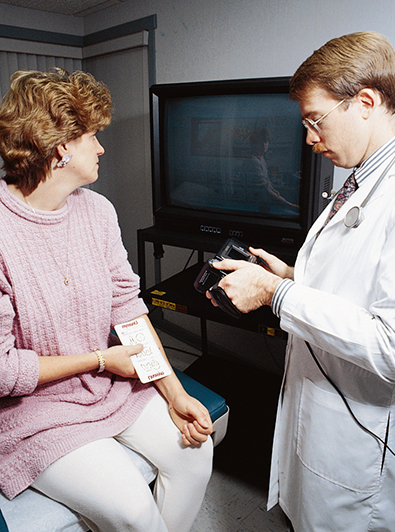Computer-Based Medical System
It would be a major spaceborne dilemma. Halfway to the planet Mars, a crew member complains of an acute, internal pain. Accurate diagnosis of this potentially life-threatening condition is required quickly. What can be done? The 21st century answer to the problem is now available.
A medical information and diagnostic support system designed for space travel has found new earthbound applications. Supported by contracts through the Kennedy Space Center, early work on the medical communications system was done under the NASA project, System 2000, also known as S2000.
Originally prompted by the need to help astronauts diagnose their own illnesses, S2000 has led to new health care hardware and software—an electronic medical library and record keeping system. Doctors can now better inform patients about their care, keep paperless medical records, prevent dangerous drug interactions and confirm diagnoses.
Over a period of 15 years, under NASA funding, Ralph Grams, MD, a medical systems specialist at the University of Florida's College of Medicine, developed the computer hardware and software system. To stimulate commercial adoption of the concept, NASA relinquished their copyright interests in the software development to the University of Florida.
In 1995, Grams founded SyMed, Inc. of Gainesville, Florida, a company which would dramatically improve the effectiveness of the system for single/multiple physician practices and clinics. That same year, SyMed finalized a licensing agreement with the University of Florida to obtain the exclusive, worldwide rights to the intellectual property for a 25-year period. The agreement also grants SyMed the sole ownership of any improvements, enhancements, or modifications made to the S2000 software during this same time period.
"Computer-based, medical interactive care systems will revolutionize how we take care of patients," says Grams. "The physical examination room will be transformed into a multimedia teaching studio, where physicians can pack into a brief exam a great deal of useful medical information that patients and their families can leave with," he adds.
At the very heart of SyMed's S2000 is an advanced "patient friendly" feature, microcomputer access to the latest medical information from twelve reference books, some 1,000 medical journals, and an atlas of human anatomy. The program features digital dictation and transcription, automated storage and retrieval of patients' records, information on more than 20,000 drugs and their side effects, and video pictures and sound bytes recorded during the physical examination for the patient's medical chart.
"Patients will see their health problems and therapy explained in full color animation and surround-sound, with their lab and radiology information retrieved instantly and projected on a large-screen TV or wall screen. Patients will review this information alongside their doctor, so they can become thoroughly informed about their health problems and how to best treat them," Grams explains.
The technology spinoff company reached out to the Southeast Regional Technology Transfer Center, operated by the Southern Technology Applications Center (STAC) at the University of Florida. STAC staff helped SyMed to establish business affiliations with an international sales network. STAC also provided a technology assessment of SyMed's S2000 and reviewed their business plan, and brought in a management consultant to focus on raising capital and finding a strategic partner. STAC introduced Grams to Ernest Moyer, a local businessman and technology commercialization specialist. Moyer's talents enabled the finalizing of a fair and equitable license agreement with the University, raised the necessary initial capital required by the company to proceed, and took on administrative and financial tasks that an early-stage company needs to perform.
In April 1997, SyMed announced it had negotiated a strategic alliance with Soft Computer Consultants of Palm Harbor, Florida. This alliance is expected to strengthen and open up SyMed's S2000 capabilities for reaching out to hospitals and other large health care institutions.
"An automatic, interactive medical office system would let physicians make better use of their time during the brief doctor/patient encounter and actually help them build stronger relationships and trust with their patients," Grams says.

The physician inspects a mole on patient's arm with a novel computerized microcomputer. A system that came out of a NASA medical communications project.













